Photo: tumblr.com
Reading Time: 10 minutesISIS originated about a decade ago as an Al Qaeda offshoot and it is now a state within a state, complete with a “capital” in Raqqa, Syria. The movement controls a huge territory around Syria and Iraq. In response to rapid territorial gains made by ISIS and internationally condemned brutality, reported human rights abuses and the fear of further spillovers of the Syrian Civil War, many states began to intervene against ISIS.
The most powerful countries like Russia, the United States of America, France and Great Britain are playing the main role fighting ISIS. All the political leaders agreed that contribution should come mainly through the airpower.
There are huge stories and memorable history behind the airpower of each country. The main elements of the modern airpower are fighter jets. The air war over Syria has seen most advanced warplanes from around the world. So, let’s take a look at the fighter jets and their configurations, which are in use fighting ISIS in Iraq and Syria.
Russian airpower – legendary Sukhoi
In September of 2015, Russian forces, at the request of the Syrian government, began hundreds of bombing raids against Syrian rebel groups, including ISIS. The first series of air strikes took place on the 30th of September in 2015 in areas around the cities of Homs and Hama, targeting the opposition and infrastructure of ISIS. All the bombing raids were made with help of Sukhoi fighter jets.
Sukhoi Su-24 M2 Fencer

Russian long-range striking power in the region comes at the courtesy of the venerable Su-24M2 Fencer. Russia has deployed twelve of the distinctive twin-engine, variable geometry wing jets to its base in Latakia.
The Su-24M front-line bomber is designed to penetrate hostile territory and destroy ground and surface targets in any weather conditions, by day and night. The aircraft, which is able to penetrate enemy airspace at low altitude, can hit targets as far as 400 miles away without aerial refueling.
Russia’s fleet of Su-24s has been heavily upgraded with modern systems. New version of Fencer is equipped with GLONASS satellite navigation systems, an upgraded glass cockpit, a modern head-up display and an upgraded air-to-air self-defense capability.
Sukhoi Su-25 Frogfoot

Su-25 Frogfoot is a single-seat, twin-engine jet aircraft developed in the Soviet Union by the Sukhoi Design Bureau. It was designed to provide close air support for the Soviet Ground Forces.
The Russian air force has upgraded dozens of Su-25s to the latest SM standard, which includes a glass cockpit, a GLONASS satellite navigation system and modern avionics.
Russian air force will likely upgrade its entire Su-25 fleet since the Frogfoot still plays an important role in the service’s order of battle—as demonstrated by the Syrian deployment.
Sukhoi Su-30SM Flanker
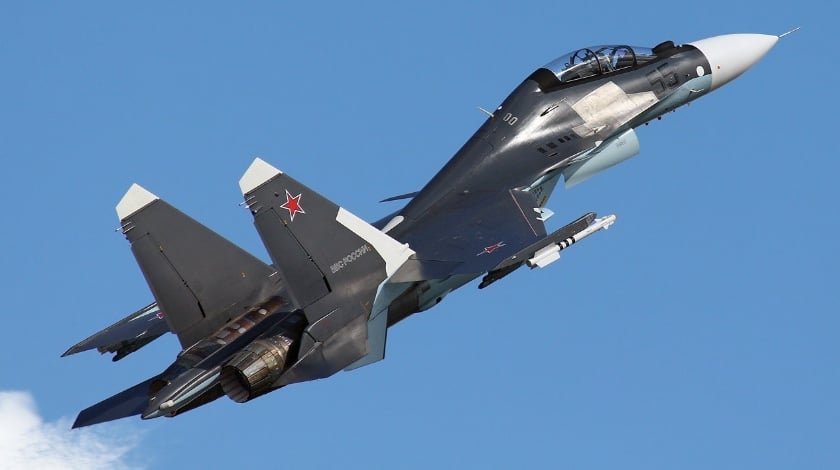
Russia has selected the Su-30SM for the Syrian operation and it is a logical choice. The aircraft can carry a hefty payload and it has excellent range. Moreover, it offers the flexibility to carry out air-to-air and air-to-ground missions. That means it doesn’t need a separate fighter escort. The aircraft has a second crewmember, which is helpful for complex missions.
Several Su-30SMs were sent to Syria in the Russian military intervention in Syria to escort bombers that launch airstrikes against Islamist rebel groups.
Su-30SM fighters were reportedly delivered to the al-Assad International Airport in Latakia, Syria in September 2015. At least 4 Su-30SM fighters were spotted in a satellite photo. In late December 2015, there were 16 Su-30SMs at Khmeimim air base.
Sukhoi Su-34 Fullback
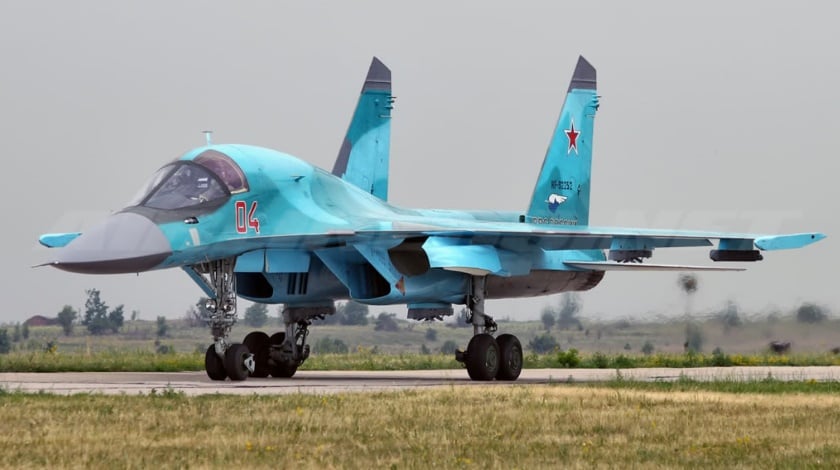
The two-seat Su-34 is primarily designed to destroy a variety of ground and naval targets. It is capable of performing solo and group missions in daytime and at night, under favorable and adverse weather conditions and in a hostile environment.
The Su-34 was the last fixed-wing combat aircraft type to arrive at Russia’s growing air base south of Latakia in Syria and is currently flying combat operations over the troubled country.
The Su-34 remains a major part of the Russian rearmament initiative. The massive military commitment – in the billions of dollars – will see all-new air force, naval and army assets added to the modernization effort under President Putin’s watch.
The manufacturer’s website states that the Su-34 is designed to defeat the F-15, F/A-18 and Eurofighter Typhoon in air combat engagements. Four Su-34 Fullback strike fighters of the Russian Air Force were deployed in Syria. They joined some 600 Russian ground troops.
U.S. Air Force – the airpower starts with “F”
On August 26th, 2014, the U.S. began sending surveillance flights, including drones, over Syria to gather intelligence on ISIS targets. The gathered intelligence helped future airstrikes planning.
On September 22nd, 2014, the United States of America and other partner nations had undertaken strikes in Syria using fighter jets, bombers, and Tomahawk missiles.
On the 15th of January 2015, it was reported that over 16,000 airstrikes had been carried out by the Coalition. The U.S. Air Force has carried out around 60 percent of all strikes.
McDonnell Douglas F-15E Strike Eagle

The F-15E “Strike Eagle” is a dual-role version of the highly successful base F-15 air superiority fighter. The Strike Eagle is intended to fulfill both roles of air-to-air superiority and ground strike with the capability to operate in all weather, low altitude and day/night sorties thanks to a battery of improved internal systems.
The “Strike Eagle” has a system that can fight its way into enemy’s territory, destroy its assigned ground targets, and then fight its way back out all on its own without the need for dedicated air support elements. Unlike the original F-15 Eagle design, the Strike Eagle features a two-seat cockpit with tandem seating for the pilot and weapons systems officer.
The forward cockpit is accentuated by the informational Heads-Up Display (HUD) system, which allows the pilot to keep his eyes on the area ahead without having to look down at the instrument panel and transform night operations to a clear and seemingly day lit view.
F-15Es has been used by the U.S. in airstrikes against Islamic State fighters, training compounds, headquarters and command and control facilities, storage facilities, a finance center, supply trucks, and armed vehicles. F-15Es flew 37 percent of Air Force sorties.
Lockheed Martin F-16 Fighting Falcon
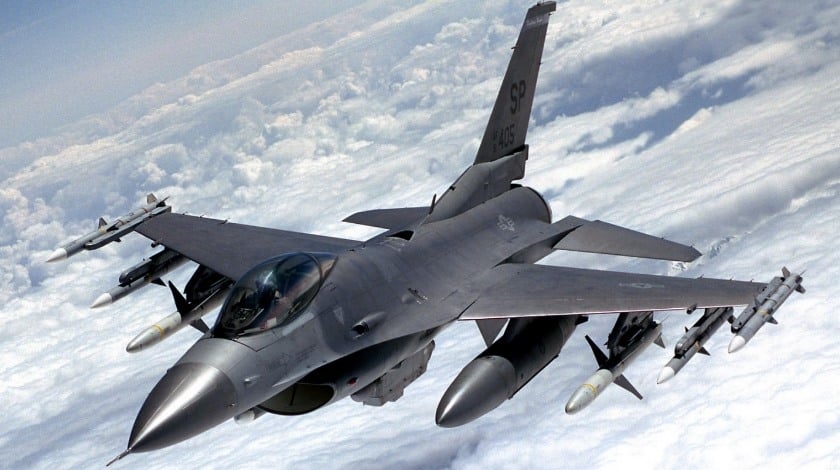
The F-16 Fighting Falcon is a single-engine, multi-role fighter aircraft. It is highly maneuverable and has proven itself in air-to-air combat and air-to-surface attack. Designed as an air superiority day fighter, it evolved into a successful all-weather multirole aircraft. It provides a relatively low-cost, high-performance weapon system for the United States and allied nations.
It can locate targets in all weather conditions and detect low flying aircraft in radar ground clutter. F-16 can fly more than 500 miles (860 kilometers), deliver its weapons with superior accuracy, defend itself against enemy aircraft, and return to its starting point.
During the airstrikes in Syria F-16 multirole fighters flew a variety of missions to include suppression of enemy air defense, offensive and defensive counter air, close air support and forward air controller missions. Mission results were outstanding as these fighters destroyed radar sites, vehicles, tanks and buildings.
McDonnell Douglas F/A-18 Hornet

F/A-18 Hornet is a twin-engine supersonic, all-weather carrier-capable multirole combat jet, designed as both a fighter and attack aircraft. The fighter’s primary missions are fighter escort, fleet air defense, Suppression of Enemy Air Defenses (SEAD), air interdiction, close air support and aerial reconnaissance.
All F/A-18s can be configured quickly to perform either fighter or attack roles or both, through selected use of external equipment to accomplish specific missions. This “force multiplier” capability gives the operational commander more flexibility in employing tactical aircraft in a rapidly changing battle scenario.
The initial strikes against ISIS were delivered by F/A-18 Hornets, launched from USS George H.W. Bush. Since then, F/A-18s appear to have carried out the bulk of the strikes. Carrier-based fighters have proven particularly useful because they have a limited political footprint.
Lockheed Martin F-22 Raptor
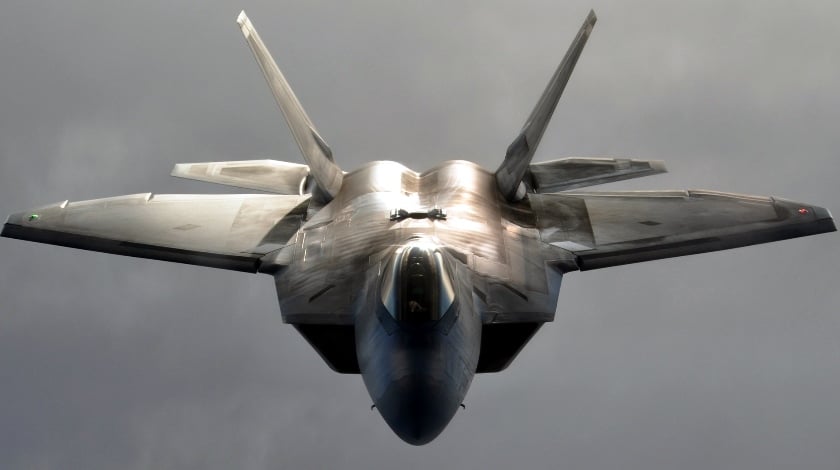
The Lockheed Martin F-22 Raptor is a fifth-generation single-seat, twin-engine, all-weather stealth tactical fighter aircraft developed for the United States Air Force. The aircraft was designed primarily as an air superiority fighter, but has additional capabilities including ground attack, electronic warfare, and signals intelligence roles.
The Raptor’s combination of stealth, aerodynamic performance, and situational awareness gives the aircraft unprecedented air combat capabilities.
For the United States of America, the stealthy Lockheed Martin F-22 Raptor will be America’s premier weapon to ensure dominance over the skies in the territory controlled by ISIS.
In its first months of combat in the skies above Iraq and Syria, the stealthy jet’s contribution has been more of an escort role, using its high-tech sensors and communications to guide and protect other fighters that are actually dropping the bombs.
UK Royal Air Force – from Typhoon to Tornado!
On the 2nd of December 2015, following the November 2015 Paris attacks and United Nations Security Council Resolution 2249, David Cameron opened a ten-hour debate in Parliament on Syrian airstrikes and the majority decided to let the Royal Air Force work in Syria.
Airstrikes commenced two hours after the vote, taking place in eastern Syria against the ISIS-held Oman oilfield. UK’s air force based in Cyprus would double, with the addition of six Eurofighter Typhoons and two Tornado GR4s.
Eurofighter Typhoon
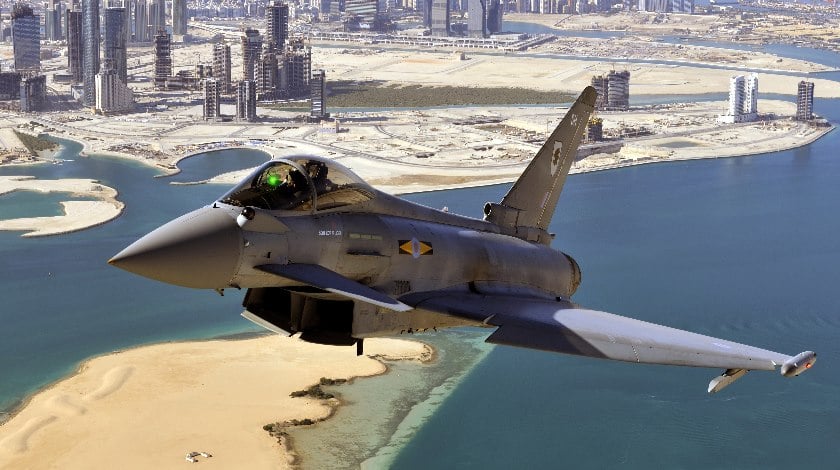
The Eurofighter Typhoon is a twin-engine, canard-delta wing, multirole fighter. The Typhoon was designed and is manufactured by a consortium of three companies; Alenia Aermacchi, Airbus Group and BAE Systems.
The Eurofighter Typhoon is a highly agile aircraft, designed to be a supremely effective dogfighter when in combat with other aircraft. Eurofighter Typhoon developed originally as a purebred air superiority fighter.
On the 3rd of December 2015 six Typhoons deployed to RAF Akrotiri to support operations against ISIS. The following evening Typhoons attacked targets in Syria.
Panavia Tornado GR4
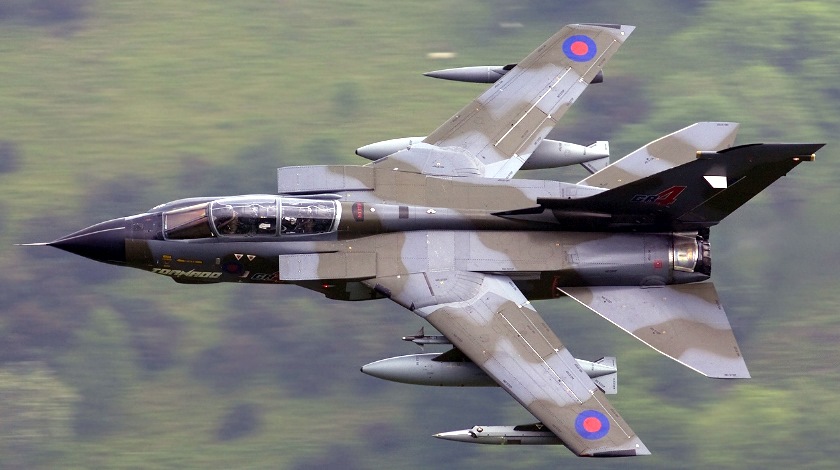
The Panavia Tornado is a twin-engine, multirole, variable-sweep wing combat aircraft, which was jointly developed and manufactured by Italy, the United Kingdom, West Germany and designed to excel at low-level penetration of enemy defenses.
Compared with the Typhoon, which entered service in 2007, the much older Tornado is less maneuverable, having been primarily designed to fly quickly in straight lines at a low level.
On the 29th of September 2014, three days after Parliament approved of airstrikes against Islamic State forces inside Iraq, two Tornados conducted their first armed reconnaissance mission over the country.
By the 1st of March 2015, eight RAF Tornados had been deployed to Akrotiri and conducted 159 airstrikes against ISIS targets in Iraq.
Same as Eurofighter Typhoon, Panavia Tornado was selected to combat the growing threat of ISIS.
French Air Force – Rafale’s revenge from above
On the 19th of September 2014, the French Air Force used its Rafale jets to conduct airstrikes on ISIS targets in Mosul. France was committed to fighting ISIS using air power alongside the United States of America. To conduct its airstrikes, France deployed 9 Rafale fighters to the United Arab Emirates, 6 Dassault Mirage 2000 fighters to Jordan.
After the November 2015 Paris attacks, the French Air Force launched its largest airstrike of the bombing campaign sending 12 planes, including 10 fighters to bomb training camps and ammunition facilities in Raqqa, the de facto capital of ISIS.
Dassault Rafale

The Dassault Rafale is a French twin-engine, canard delta wing, multirole fighter aircraft. The Rafale was developed as a modern jet fighter with a very high level of agility. Dassault chose to combine a delta wing with active close-coupled canard to maximize maneuverability. The Rafale is an aerodynamically unstable aircraft and uses digital fly-by-wire flight controls to artificially enforce and maintain stability.
The Rafale is a 9.5 – 10.5 tonne aircraft powered by 2 SNECMA M88 jet engines, each generating up to 16,500 pounds thrust with afterburner. Canards are used to improve maneuverability, especially for snap-shots in short-range dogfights, and radar shaping lowers the aircraft’s profile relative to 4th generation competitors like the Mirage 2000 or F-16.
French Air Force used its Rafale jets to conduct airstrikes on ISIS targets.
Dassault Mirage 2000
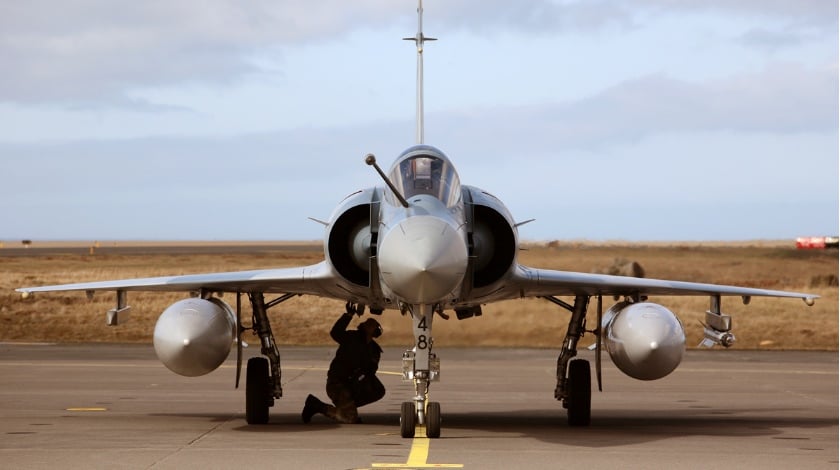
Mirage 2000 is a multirole combat fighter from Dassault Aviation of France features a low-set thin delta wing with cambered section, 58 degrees leading-edge sweep and moderately blended root and two small canard wings, fixed, and placed just behind the air intakes. It has been operational with the French Air Force since 1984.
The flight surfaces on the wings are composed of four elevons and four leading edge slats. Its neutral point is in front of its centre of gravity, giving the fighter relaxed stability to enhance maneuverability. It incorporates negative stability and fly-by-wire controls with four analog computers.
The Mirage 2000 is available as a single-seat or two-seat multi-role fighter. The pilot flies the aircraft by means of a center stick and left hand throttles, with both incorporating hands-on-throttle-and-stick controls.
To conduct its airstrikes in Syria French Air Force deployed 6 Dassault Mirage 2000 fighters to Jordan and since now they are conducting air missions fighting ISIS.
Conclusion
An overview of air forces and fighter jets of the major countries involved in the fight against ISIS leaves us with concerns. Many of you are probably wondering what would be if one day they have to fight with one another. Civilized society certainly would not want to see it all in the backyard of their houses.
Moreover, we should always keep in mind that the fighter jet is controlled by pilot even if it is modern and technically developed. Sometimes pilot can be led by his beliefs, ground preparation or professional anger which is focused on the fight against terrorism and unites all the countries doing the same job. Let‘s hope that after ISIS will be defeated all the fighter jets will be used only for defense purposes.

